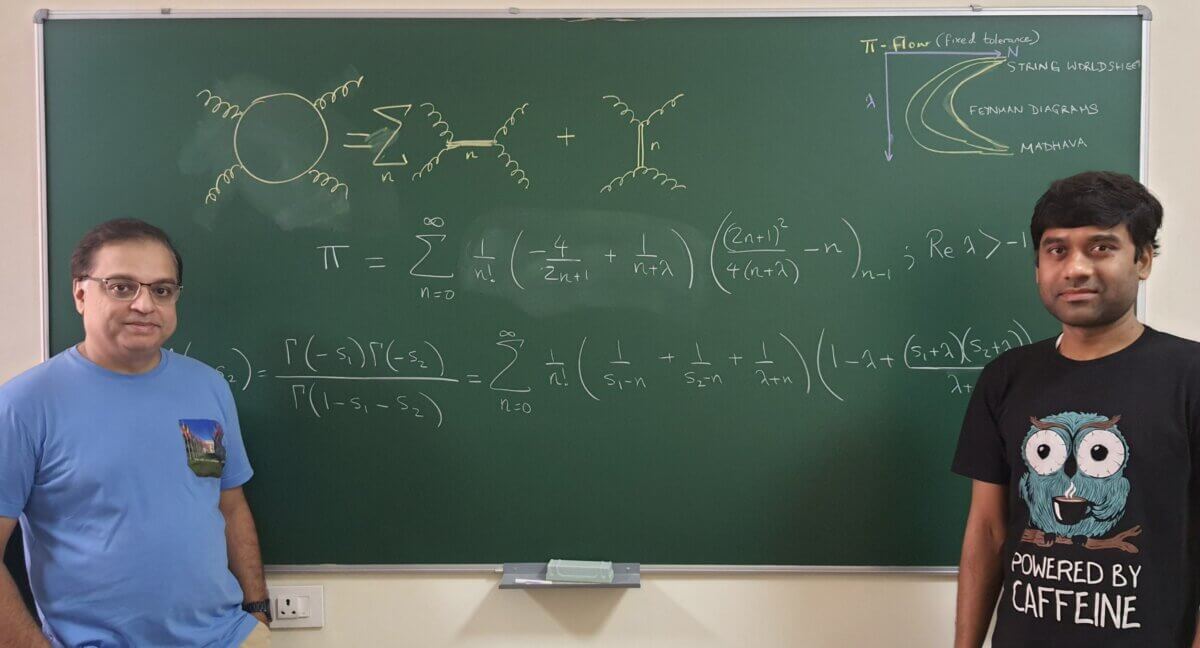
(Credit: Kuki Ladron de Guevara/Shutterstock)
BANGALORE, India — In an unexpected twist, a recent study in theoretical physics has yielded a novel way to represent one of mathematics' most famous constants: pi. This exciting discovery by researchers at the Indian Institute of Science emerged as a byproduct of their work on string theory amplitudes.
While the primary focus of their research was to bridge the gap between string theory and quantum field theory, the mathematically inclined will find particular interest in a surprising offshoot of their work – a new series representation for pi that converges remarkably fast. The paper, co-authored by Arnab Saha, a post-doctoral researcher, and Aninda Sinha, a professor at the Centre for High Energy Physics (CHEP), is published in Physical Review Letters.
The traditional series for pi, known as the Madhava series (also called the Leibniz series), is well-known for its simplicity but notorious for its slow convergence. It takes a staggering five billion terms to achieve just 10 decimal places of accuracy. In contrast, the new representation derived by Saha and Sinha can achieve the same precision with just 30 terms, marking a significant leap in computational efficiency.
This new formula for pi is not just a mathematical curiosity; it represents a fascinating connection between the abstract world of string theory and the concrete realm of number theory. It emerges from considerations of the open string amplitude, a fundamental object in string theory that describes how strings interact.
The researchers' formula takes the form:
π = 4 + Σn=1 to ∞ * [(1/(n+λ)) - (4/(2n+1))] * [(((2n+1)^2)/(4(n+λ)) - n]^(n-1)
Here, λ is a parameter that can be adjusted to optimize convergence. When λ approaches infinity, this new series reduces to the classic Madhava series, providing a satisfying link to traditional mathematics.
What makes this representation particularly intriguing is its rapid convergence. By choosing λ values between 10 and 100, the series can quickly approximate pi to high precision with relatively few terms. This efficiency could have practical applications in computational mathematics, where fast and accurate calculations of pi are often needed.

Methodology
The path to this new representation of pi was not straightforward. It emerged from the researchers' work on developing new ways to express string theory amplitudes. Their approach involved creating a novel type of dispersion relation – a mathematical tool that relates different aspects of particle interactions in physics.
Starting with a generalized version of the Euler-Beta function, which is crucial in describing certain string theory amplitudes, the team applied constraints based on quantum field theory principles. These constraints led to new series representations for various mathematical functions, including the one for pi.
The specific formula for pi was derived by setting particular values (s1 = -1/2 = s2) in their expression for the open string amplitude. This demonstrates how deeply interconnected different areas of mathematics and theoretical physics can be – a result aimed at understanding fundamental particle interactions has led to a new way of computing one of the most important mathematical constants.
Results
While the new representation of pi is a fascinating outcome, it's important to note that it was not the primary goal of the research. The main results of the study were centered around new ways to express string theory amplitudes that make them more similar to quantum field theory calculations. These include:
- A representation of string theory amplitudes that explicitly shows poles in all channels of particle interactions.
- The ability to truncate the infinite series of string theory to a finite number of terms while preserving key features.
- A natural emergence of the open superstring amplitude when certain physical constraints are imposed.
The pi representation emerged as an intriguing mathematical byproduct of these physical insights. Similarly, the researchers also found new, rapidly converging series for other mathematical constants, including the Riemann zeta function.
Limitations
As with any scientific advancement, there are limitations to consider:
- While the new pi series converges much faster than the traditional series, it's more complex and may be less intuitive to understand.
- The optimal choice of the λ parameter for fastest convergence is not immediately obvious and may require some experimentation.
- The physical interpretation of λ in the context of string theory is not yet fully understood.
Discussion and Takeaways
The discovery of this new representation of pi highlights several important points:
- Interdisciplinary connections: This finding demonstrates how research in one area (theoretical physics) can yield unexpected results in another (pure mathematics). It underscores the deep interconnections between different branches of science and mathematics.
- Computational efficiency: The rapid convergence of the new series could have practical applications in fields requiring high-precision calculations of pi.
- New mathematical tools: Along with the pi representation, the research yielded new series for other mathematical constants, potentially providing new tools for mathematicians and physicists alike.
- Fundamental insights: The connection between this pi representation and string theory amplitudes hints at deep, underlying relationships between geometry (represented by pi) and the fundamental structure of the universe as described by string theory.
- Potential for further discoveries: This unexpected result suggests that further exploration of string theory and quantum field theory connections could yield more surprising mathematical insights.
While the new representation of pi was not the main focus of Saha and Sinha's research, it stands as a testament to the unexpected ways in which abstract theoretical physics can connect to concrete mathematics.
As research in theoretical physics continues to push the boundaries of our understanding, we may well find more such surprising connections lurking in the abstract realms of higher mathematics and fundamental physics.










